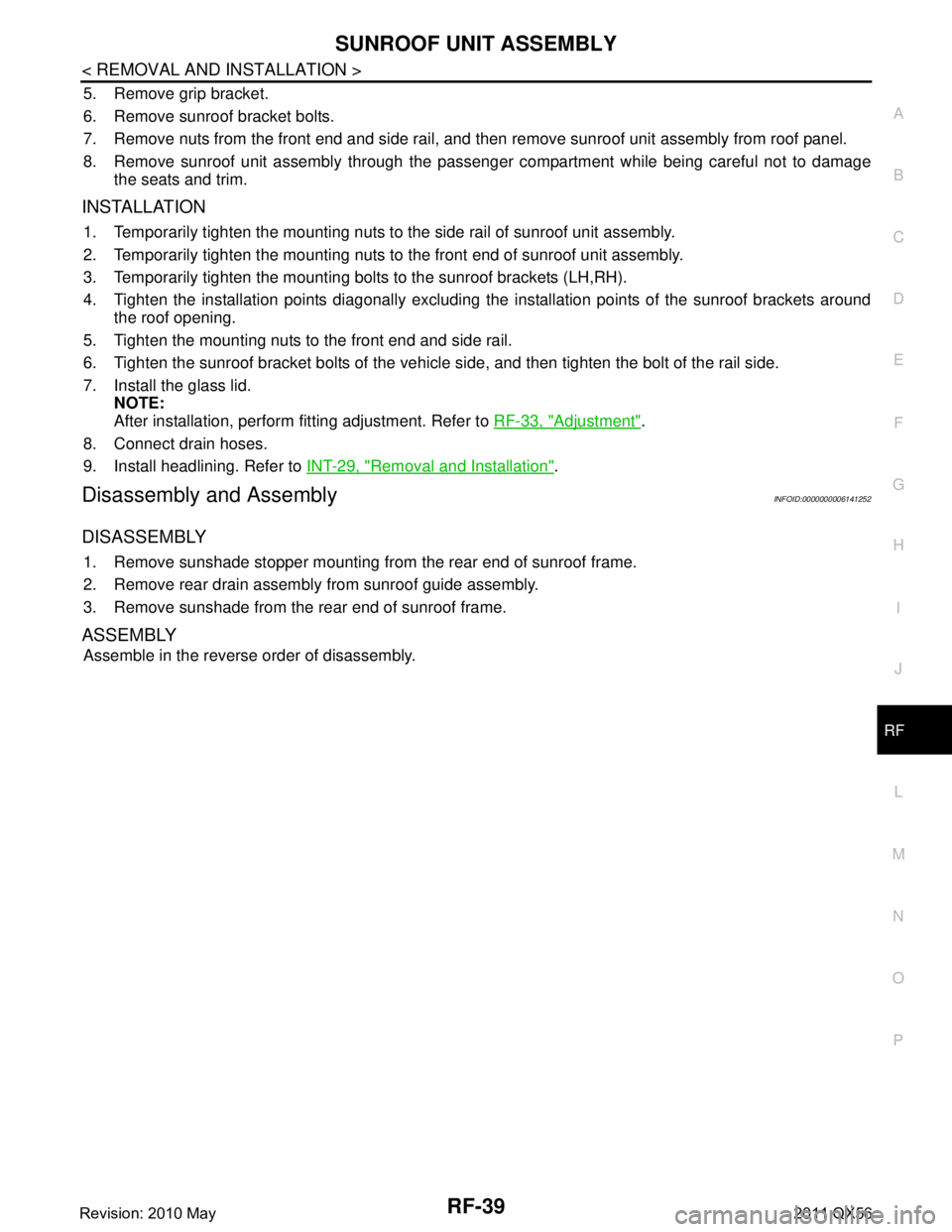Page 4246 of 5598
RF-32
< REMOVAL AND INSTALLATION >
GLASS LID
REMOVAL AND INSTALLATION
GLASS LID
Exploded ViewINFOID:0000000006141245
1. Glass lid 2. TORX bolt 3. Side trim
4. Rear drain connector 5. Rear drain hose 6. Sunroof bracket (LH,RH)
7. Front drain hose 8. Front drain connector 9. Sunroof motor assembly
10. Sunroof unit assembly
JMKIA5212ZZ
Revision: 2010 May2011 QX56
Page 4249 of 5598
SUNROOF MOTOR ASSEMBLYRF-35
< REMOVAL AND INSTALLATION >
C
DE
F
G H
I
J
L
M A
B
RF
N
O P
SUNROOF MOTOR ASSEMBLY
Exploded ViewINFOID:0000000006141248
1. Glass lid 2. TORX bolt 3. Side trim
4. Rear drain connector 5. Rear drain hose 6. Sunroof bracket (LH,RH)
7. Front drain hose 8. Front drain connector 9. Sunroof motor assembly
10. Sunroof unit assembly
JMKIA5212ZZ
Revision: 2010 May2011 QX56
Page 4251 of 5598
SUNROOF UNIT ASSEMBLYRF-37
< REMOVAL AND INSTALLATION >
C
DE
F
G H
I
J
L
M A
B
RF
N
O P
SUNROOF UNIT ASSEMBLY
Exploded ViewINFOID:0000000006141250
REMOVAL
DISASSEMBLY
1. Glass lid 2. TORX bolt 3. Side trim
4. Rear drain connector 5. Rear drain hose 6. Sunroof bracket (LH,RH)
7. Front drain hose 8. Front drain connector 9. Sunroof motor assembly
10. Sunroof unit assembly
JMKIA5212ZZ
Revision: 2010 May2011 QX56
Page 4253 of 5598

SUNROOF UNIT ASSEMBLYRF-39
< REMOVAL AND INSTALLATION >
C
DE
F
G H
I
J
L
M A
B
RF
N
O P
5. Remove grip bracket.
6. Remove sunroof bracket bolts.
7. Remove nuts from the front end and side rail, and then remove sunroof unit assembly from roof panel.
8. Remove sunroof unit assembly through the passenger compartment while being careful not to damage the seats and trim.
INSTALLATION
1. Temporarily tighten the mounting nuts to the side rail of sunroof unit assembly.
2. Temporarily tighten the mounting nuts to the front end of sunroof unit assembly.
3. Temporarily tighten the mounting bolts to the sunroof brackets (LH,RH).
4. Tighten the installation points diagonally excluding the installation points of the sunroof brackets around the roof opening.
5. Tighten the mounting nuts to the front end and side rail.
6. Tighten the sunroof bracket bolts of the vehicl e side, and then tighten the bolt of the rail side.
7. Install the glass lid. NOTE:
After installation, perform fitting adjustment. Refer to RF-33, "
Adjustment".
8. Connect drain hoses.
9. Install headlining. Refer to INT-29, "
Removal and Installation".
Disassembly and AssemblyINFOID:0000000006141252
DISASSEMBLY
1. Remove sunshade stopper mounting from the rear end of sunroof frame.
2. Remove rear drain assembly from sunroof guide assembly.
3. Remove sunshade from the rear end of sunroof frame.
ASSEMBLY
Assemble in the reverse order of disassembly.
Revision: 2010 May2011 QX56
Page 4561 of 5598

SE-102
< SYMPTOM DIAGNOSIS >
SQUEAK AND RATTLE TROUBLE DIAGNOSES
Most of these incidents can be repaired by adjusting, securing or insulating the item(s) or component(s) caus-
ing the noise.
SUNROOF/HEADLINING
Noises in the sunroof/headlining area c an often be traced to one of the following:
1. Sunroof lid, rail, linkage or seals making a rattle or light knocking noise
2. Sunvisor shaft shaking in the holder
3. Front or rear windshield touching headlining and squeaking
Again, pressing on the components to stop the noise while duplicating the conditions can isolate most of these
incidents. Repairs usually consist of insulating with felt cloth tape.
SEATS
When isolating seat noise it's important to note the position the seats in and the load placed on the seat when
the noise occurs. These conditions should be duplicated when verifying and isolating the cause of the noise.
Cause of seat noise include:
1. Headrest rods and holder
2. A squeak between the seat pad cushion and frame
3. The rear seatback lock and bracket
These noises can be isolated by moving or pressing on the suspected components while duplicating the con-
ditions under which the noise occurs.Most of these incidents can be repaired by repositioning the component
or applying urethane tape to the contact area.
UNDERHOOD
Some interior noise may be caused by components under the hood or on the engine wall. The noise is then
transmitted into the passenger compartment.
Causes of transmitted underhood noise include:
1. Any component mounted to the engine wall
2. Components that pass through the engine wall
3. Engine wall mounts and connectors
4. Loose radiator mounting pins
5. Hood bumpers out of adjustment
6. Hood striker out of adjustment
These noises can be difficult to isolate since they cannot be reached from the interior of the vehicle. The best
method is to secure, move or insulate one component at a time and test drive the \
vehicle. Also, engine RPM
or load can be changed to isolate the noise. Repairs can usually be made by moving, adjusting, securing, or
insulating the component causing the noise.
Revision: 2010 May2011 QX56
Page:
< prev 1-8 9-16 17-24